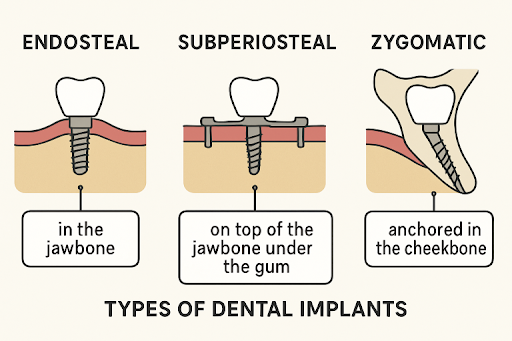Key Takeaways
- Reviewing the types of dental implants helps you choose the best fit for your needs.
- Critical factors like implant material, procedure complexity, and financial planning affect your decision-making process.
- Professional consultation ensures your treatment plan is based on your individual oral health and goals.
Table of Contents
- Types of Dental Implants
- Factors to Consider When Choosing an Implant
- The Importance of Professional Consultation
- Cost Considerations and Financial Planning
- Technological Advancements in Implant Dentistry
- Patient Experiences and Satisfaction Rates
- Potential Risks and How to Mitigate Them
- Conclusion
Dental implants are transforming the landscape of tooth replacement, providing lasting and natural-looking solutions for people who have lost teeth due to a variety of causes. With advancements in technology and a range of choices available, it’s vital to have accurate information to confidently select the best option for you. Exploring Dental Implants Orlando, FL, can offer a starting point for those seeking expert care and up-to-date implant solutions in Central Florida.
As you weigh your choices, understanding how different implant types and procedures address unique dental needs is essential. From considering implant location and material to reviewing recovery and cost factors, making an informed decision is easier when you know what to expect. Dental professionals play a crucial role in guiding you through each step, ensuring you achieve optimal outcomes tailored to your health and lifestyle.
Educating yourself on the process and technological advancements not only sets expectations but also empowers you to ask the right questions during your consultation. High-quality information is one of your best tools to ensure your new smile is as healthy and long-lasting as possible.

Types of Dental Implants
Dental implants are not one-size-fits-all; each type is designed to meet specific dental or structural needs. According to WebMD, endosteal implants are the most commonly used and are inserted directly into the jawbone, mimicking natural tooth roots. Subperiosteal implants sit under the gum but on or above the jawbone and are ideal for patients who don’t have enough healthy jawbone for endosteal implants. For more complex cases, zygomatic implants are anchored in the cheekbone and provide a solution when the upper jaw lacks sufficient bone mass.
Knowing the differences among these options can help determine which implant offers the best function, stability, and appearance for your situation.
Factors to Consider When Choosing an Implant
When selecting a dental implant, thorough evaluation and personal preference matter. Key factors include:
- Material: Titanium implants are biocompatible and durable, but zirconia is sometimes recommended for individuals with metal allergies or those seeking a metal-free option.
- Complexity of the Procedure: Some implants require several steps and multiple visits, while “mini” implants or immediate-load options can sometimes be completed more quickly and with less surgery.
- Longevity and Care: Dental implants generally last decades if cared for properly, but ask about the expected lifespan and maintenance requirements, which may vary by type.
Weighing these factors alongside your medical history and future dental health goals positions you for long-term satisfaction.
The Importance of Professional Consultation
Expert advice is vital to success with dental implants. A licensed dental professional will perform a holistic assessment, including bone quality, gum health, and overall readiness for surgery. A personal consultation allows you to discuss concerns and get tailored recommendations for implant type, materials, and aftercare strategies. The American Dental Association and other leading organizations stress that collaboration with well-qualified providers significantly improves patient safety and overall satisfaction.
Cost Considerations and Financial Planning
The investment required for dental implants varies depending on the complexity of your case, implant type, and geographic location. It’s smart to clarify several key points beforehand:
- Insurance Coverage: Review your dental and medical insurance options, as coverage may differ by procedure and policy.
- Flexible Payment Plans: Many clinics provide structured financing or payment solutions to make implants more accessible.
- Financial Assistance: Consider healthcare credit options, nonprofit assistance, or employer-sponsored benefits to offset costs.
A transparent discussion with your provider about the financial aspects ensures there are no surprises as you move forward.
Technological Advancements in Implant Dentistry
Recent years have brought significant advancements in both implant materials and placement techniques. Three-dimensional (3D) imaging and computer-guided surgery allow for incredibly precise implant placement, boosting the likelihood of success and minimizing discomfort. New surface treatments improve the integration of implants with bone, reducing healing times. Modern tools like 3D modeling help maximize fit and function while providing patients with a visual roadmap for their treatment plan.
Potential Risks and How to Mitigate Them
Dental implants are generally safe, but like all surgical procedures, there are some potential risks. Complications can include infection, nerve injury, and implant failure. Risks can be dramatically reduced by:
- Choosing a skilled and credentialed dental professional for your treatment.
- Strictly adhering to post-procedure instructions regarding home care and medications.
- Attending regular dental check-ups so any issues are caught early and managed promptly.
Informed, diligent aftercare and provider selection are key to avoiding preventable problems and ensuring your implant’s long-term health.
Conclusion
Selecting the right dental implant solution is a process that involves thoughtful research, an understanding of the options, and partnership with experienced dental professionals. By staying informed and proactive, you can look forward to a safe, successful procedure and a restored smile that enhances your overall health and self-confidence.



